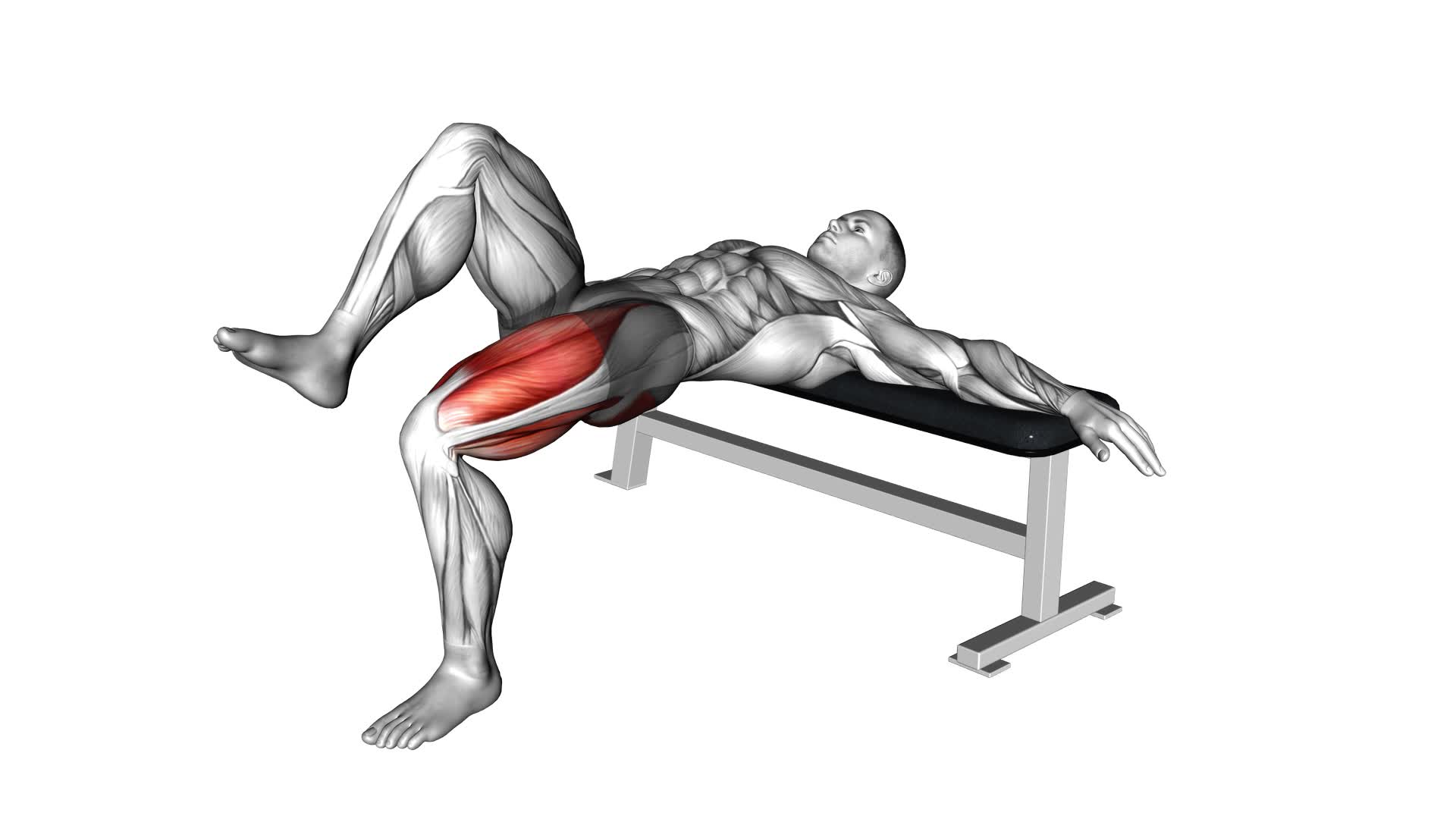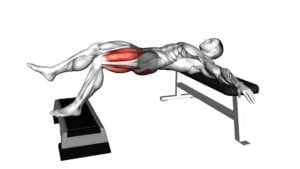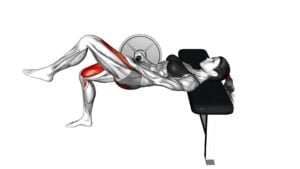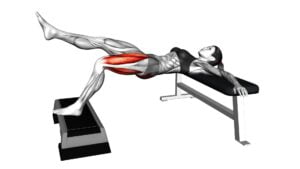Single Leg Hip Thrust – Video Exercise Guide & Tips

Looking to target your glutes and build strength in your hips? The Single Leg Hip Thrust is the exercise for you.
Watch This Exercise Video
In this video exercise guide, we'll show you the proper form and technique, common mistakes to avoid, and ways to progress and modify the exercise.
With our expert tips, you'll get the most out of your Single Leg Hip Thrust workout.
So grab your mat and let's get started!
Key Takeaways
- The single leg hip thrust strengthens and tones glutes, improves hip stability, reduces the risk of injuries, and enhances lower body strength.
- Equipment needed for the exercise includes a sturdy bench or step, optional resistance band for added challenge, and variations can be done using a barbell or stability ball.
- Proper form and technique involve lying on your back with knees bent and feet flat on the ground, extending one leg straight out in front of you, engaging glutes to lift hips off the ground, and maintaining a straight line from shoulders to knees.
- Common mistakes include improper alignment, not activating glutes properly, and straining the lower back. It is important to maintain proper form and technique to engage the correct muscles and reap the benefits of the exercise.
Benefits of the Single Leg Hip Thrust
There are three key benefits you can experience from incorporating the single leg hip thrust into your exercise routine.
First, it offers several advantages for strengthening and toning your glutes. By targeting the gluteus maximus, medius, and minimus muscles, this exercise helps to sculpt and shape your buttocks. It also improves hip stability, which can enhance your overall athletic performance and reduce the risk of injuries.
Second, the single leg hip thrust is highly effective in activating the glute muscles. Unlike traditional exercises like squats and lunges, which primarily work the quads and hamstrings, the hip thrust specifically isolates the glutes. This targeted activation maximizes muscle recruitment and allows for greater strength gains.
Lastly, incorporating the single leg hip thrust into your routine can improve your overall lower body strength. The exercise not only strengthens the glutes but also engages the core, hamstrings, and lower back muscles. This comprehensive strengthening of multiple muscle groups can lead to better functionality and increased power in activities such as running, jumping, and squatting.
Equipment Needed for Single Leg Hip Thrust
To perform the single leg hip thrust, you'll need minimal equipment. The main piece of equipment you'll need is a bench or step that's sturdy and stable. This will provide support and elevation for your upper back during the exercise.
Additionally, you may want to use a resistance band to add extra resistance and challenge to the movement. The advantages of using a resistance band include increased muscle activation and strength development in the glutes and hamstrings.
There are also variations of the single leg hip thrust that require different equipment. For example, you can perform the exercise using a barbell placed across your hips for added resistance. This variation is commonly used by advanced lifters who want to further challenge their glute muscles.
Another variation is the single leg hip thrust on a stability ball, which requires a stability ball instead of a bench. This variation enhances core stability and challenges your balance.
Now that you know the equipment needed for the single leg hip thrust, let's move on to discussing the proper form and technique for this exercise.
Proper Form and Technique for Single Leg Hip Thrust
To perform the single leg hip thrust with proper form and technique, you'll need to focus on engaging your glutes and maintaining a stable core throughout the exercise. This exercise primarily targets your glutes, hamstrings, and core muscles.
Here are three key points to remember when performing the single leg hip thrust:
- Start by lying on your back with your knees bent and feet flat on the ground. Extend one leg straight out in front of you.
- Engage your glutes and push through your heel as you lift your hips off the ground. Your body should form a straight line from your shoulders to your knees.
- Squeeze your glutes at the top of the movement and then slowly lower your hips back down, maintaining control throughout.
These points will help you maintain proper form and maximize the effectiveness of the exercise. By focusing on engaging your glutes and maintaining a stable core, you'll ensure that the targeted muscle groups are fully activated.
Now let's move on to the next section, where we'll discuss common mistakes to avoid during the single leg hip thrust.
Common Mistakes to Avoid During Single Leg Hip Thrust
To avoid common mistakes during the single leg hip thrust, make sure you maintain proper form and technique. One common mistake to watch out for is improper alignment. It's important to keep your body in a straight line from your shoulders to your knees. Avoid arching your back or letting your hips drop. This will help to engage the correct muscles and prevent strain on your lower back.
Another mistake to avoid isn't activating the glutes properly. The single leg hip thrust is designed to target the glute muscles, so it's essential to focus on activating them throughout the movement. Squeeze your glutes as you lift your hips off the ground and hold the contraction at the top for a second before lowering back down.
Ways to Progress and Modify Single Leg Hip Thrust
Now that you have learned how to avoid common mistakes during the single leg hip thrust, let's explore ways you can progress and modify this exercise.
By incorporating progression variations, you can challenge your muscles even further and continue to see improvements in strength and muscle activation. Here are three ways you can progress and modify the single leg hip thrust:
- Add resistance: Once you have mastered the bodyweight single leg hip thrust, you can increase the challenge by adding resistance. Place a barbell or a weight plate across your hips as you perform the exercise. This added weight will increase the intensity and stimulate greater muscle activation.
- Elevate your feet: By elevating your feet on a step or a bench, you create a greater range of motion and increase the difficulty of the exercise. This modification targets your glutes and hamstrings in a different way, providing a new stimulus for muscle growth.
- Perform explosive reps: To add a plyometric element to the single leg hip thrust, you can perform explosive reps. Start by lowering your hips down slowly, then forcefully thrust your hips upwards, lifting your foot off the ground. This explosive movement engages your fast-twitch muscle fibers and enhances power development.
Incorporating these progression variations into your single leg hip thrust routine will help you continue making progress and challenge your muscles in new ways. Remember to listen to your body and gradually increase the difficulty as you become stronger and more comfortable with the exercise.
Tips for Getting the Most Out of Your Single Leg Hip Thrust Workout
As you continue to progress and modify the single leg hip thrust, there are several tips that can help you get the most out of your workout.
One of the common challenges with this exercise is maintaining proper form. To ensure you're engaging the right muscles, focus on keeping your core tight and your glutes activated throughout the movement.
Another tip is to vary your foot positioning. By changing the placement of your foot, you can target different muscles and add variety to your workout. For example, placing your foot closer to your body will emphasize your glutes, while placing your foot farther away will engage your hamstrings more.
Additionally, you can modify the exercise by using a resistance band or adding weight. Using a band around your knees or holding a dumbbell or kettlebell on your hips can increase the intensity and challenge your muscles even more. Remember to start with lighter weights and gradually increase as you become more comfortable and stronger.
Frequently Asked Questions
How Many Calories Does a Single Leg Hip Thrust Burn?
A single leg hip thrust is a great exercise for targeting your glutes and hamstrings. When done properly, it can help you burn calories and increase muscle activation in those areas. However, the exact number of calories burned during a single leg hip thrust can vary depending on factors like your body weight, intensity, and duration.
To maximize calorie expenditure and muscle activation, focus on maintaining proper form and gradually increasing the intensity as you progress.
Can the Single Leg Hip Thrust Help Improve Balance and Stability?
Yes, the single leg hip thrust can help improve your balance and stability. By performing this exercise, you engage your core and work on strengthening your glutes and hips.
Unilateral exercises like the single leg hip thrust have the added benefit of targeting each side of your body individually, helping to correct imbalances and enhance stability.
Incorporating this exercise into your routine can contribute to improved overall strength and stability.
Is It Safe to Perform the Single Leg Hip Thrust if I Have a Knee Injury?
If you have a knee injury, it's important to take precautions when performing the single leg hip thrust. This exercise puts stress on the knee joint, so it may not be safe for you.
It's best to consult with a healthcare professional or physical therapist for alternative exercises that can help you work on your glutes and hips without aggravating your knee injury. They can provide you with options that will promote strength and stability while protecting your knee.
How Often Should I Incorporate Single Leg Hip Thrusts Into My Workout Routine?
To properly perform single leg hip thrusts, it's important to incorporate them into your workout routine. By doing this exercise regularly, you can reap the benefits of improved glute strength, hip stability, and overall lower body power.
However, be mindful of your knee injury and consult with a professional to ensure it's safe for you. Incorporating single leg hip thrusts a few times a week can help you achieve your fitness goals and strengthen your lower body effectively.
Can the Single Leg Hip Thrust Help Improve Sports Performance, Such as Running or Jumping?
The single leg hip thrust is a killer exercise for improving agility and enhancing explosiveness in sports like running and jumping. By targeting the glute muscles, this exercise helps to strengthen your lower body and improve power generation.
With consistent practice, you'll notice improvements in your speed, acceleration, and vertical jump. Incorporating single leg hip thrusts into your workout routine a few times a week can make a big difference in your sports performance.
Conclusion
In conclusion, the single leg hip thrust is an effective exercise for targeting and strengthening the glutes and hamstrings.
By maintaining proper form and avoiding common mistakes, you can maximize the benefits of this exercise.
Additionally, progressing and modifying the single leg hip thrust can help you continue to challenge your muscles.
Remember to incorporate these tips into your workout routine to get the most out of this exercise.

Author
Years ago, the spark of my life’s passion ignited in my mind the moment I stepped into the local gym for the first time. The inaugural bead of perspiration, the initial endeavor, the very first surge of endorphins, and a sense of pride that washed over me post-workout marked the beginning of my deep-seated interest in strength sports, fitness, and sports nutrition. This very curiosity blossomed rapidly into a profound fascination, propelling me to earn a Master’s degree in Physical Education from the Academy of Physical Education in Krakow, followed by a Sports Manager diploma from the Jagiellonian University. My journey of growth led me to gain more specialized qualifications, such as being a certified personal trainer with a focus on sports dietetics, a lifeguard, and an instructor for wellness and corrective gymnastics. Theoretical knowledge paired seamlessly with practical experience, reinforcing my belief that the transformation of individuals under my guidance was also a reflection of my personal growth. This belief holds true even today. Each day, I strive to push the boundaries and explore new realms. These realms gently elevate me to greater heights. The unique combination of passion for my field and the continuous quest for growth fuels my drive to break new ground.







